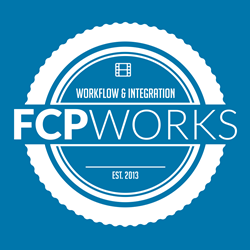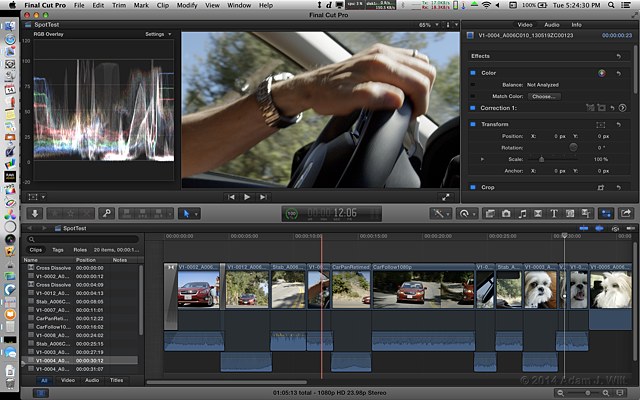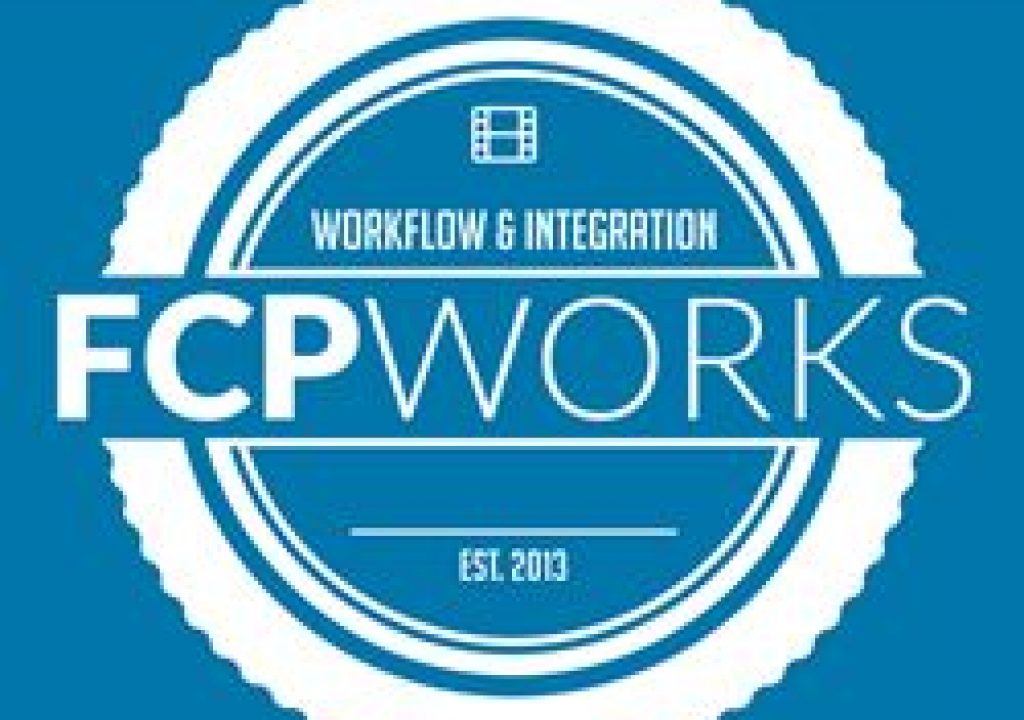Last October Kevin McAuliffe told us in two articles that Final Cut Pro X wasn't worth caring about: “FCPX is still not ready for professional use”. He caught a lot of crap for saying so, but he was right… in a very constrained context (which, if you read his rants, he carefully delineates). If you were a full-time editor working for or day-playing at an established production house, FCPX wasn't even on the radar.
But what you see depends on where you stand; editor and colorist Sam Mestman paints a considerably different picture. Mestman has over a decade of experience with Final Cut Pro, and has been using FCPX professionally since version 10.0.6. He’s CEO of the Los Angeles film collective We Make Movies, and is now the Workflow Architect for FCPWORKS, a new systems integration, training, and service company in LA.
I started an email conversation with Mestman over the weekend after hearing about the FCPWORKS special event on 25 January, and we wound up having a chat over coffee in Mountain View on Monday, as Sam was passing through on his way to LA from SF.
FCPWORKS

FCPWORKS is founded on the proposition that FCPX is a perfectly viable, fully professional NLE, and that there’s enough of a business there to support an integration company focused exclusively on it. As an Apple Authorized Reseller, FCPWORKS fully supports FCPX and the Mac platform, and integrates third party products from AJA, Blackmagic Design, Softron, Quantum, and others. Mestman explained: “When you go into the Apple Store, you can't put together a whole system. Yes, you can get the Mac and FCPX, but then you wind up going other places to get monitoring, I/O, and storage. We're aiming to be the Apple Store for pro editing: the one place where you can get all the hardware, all the software, all put together in one place.”
I told Sam that I was excited that he was taking the contrarian viewpoint and pushing FCPX as the core of professional video solution; I’ve been using FCPX since version 10.0.4, almost as a guilty pleasure. Here’s a lightly-edited version of our correspondence:
SM: It’s a dangerous game to say anything nice about Apple in the Pro Video space these days, and, well, I guess all I can say is that I keep running across people like you who’ve been using it as a “guilty pleasure”, and have a hard time admitting to it publicly. As far as I’m concerned, it’s the best kept secret in post. I’ve been using it professionally (as in, making money) since 10.6. I’m honestly sort of blown away that people find the idea of someone creating professional solutions for FCPX at this point, almost 3 years into its release, as being remotely controversial or newsworthy… but that’s life. I sort of look at the whole thing as an opportunity. The product is great, demos for clients with an open mind are easy… so, for me, it’s like, what’s the big deal? It’s a good product that allows me to edit faster than I ever have, and I’ve used FCP7 (since its inception), as well as Avid and Premiere. A lot of people think it’s crazy for some reason, but FCPWORKS is a no-brainer for me, and long overdue. The crazy thing for me is that there aren’t more people in the FCPX space that really understand how the program works.
Our goal with all this is not to convert people to FCPX. Our goal is to support the people who are already using it, and shed more light on the fact that it’s a fantastic tool for a wide range of projects. In terms of price vs. performance, nothing out there touches it. I don’t hate Avid or Premiere, I just happen to think FCPX allows me to work more efficiently than I can with those programs for the types of work I do… and I’m not alone in thinking that.
We are the only reseller I’m aware of that will be providing professional solutions built entirely around the FCPX ecosystem… for now. I’m pretty sure once people see what we’re doing there will be quite a bit more competition there from existing resellers.
AJW: Given that FCPX is said to be a not-ready-for-prime-time, unprofessional, glorified iMovie with delusions of grandeur (grin), starting up an FCPX-centric integrations and service company is a bold and audacious move, especially in the Los Angeles factory-floor editing environment. How do you respond to the FCPX naysayers? What do you see as FCPX's strengths that make it a contender against the established base of Avids, and Adobe's increasing presence among serious editors?
SM: Ha! Hilarious. Anyway, for me, the fundamental advantages to X are project prep, media management, and offline/online workflow, especially for RED shoots. What if I could show you a way to have a fully synced, properly renamed Event with completely searchable script supervisor metadata within 10 minutes of having the footage downloaded from set? What if you didn’t need to do dailies anymore and on-set post was a reality?
Then there’s stuff like the timeline index, real time effects, keywords, smart collections, favorites, skimming, etc. You’re going to see some really interesting things happen in workflow this year. The fact is that people don’t really understand how to work quickly in FCPX because it requires a fundamental change in the way established people already edit in order to take advantage of it. If you try and make a screwdriver work like a hammer, you probably won’t think the screwdriver is a very good tool.
AJW: Apple threw us under the bus when they sent Final Cut Studio to sleep with the fishes [sorry, I've been following the Chris Christie story, so mob metaphors come naturally]. They could do it again with FCPX. Why do you think FCPX has a future secure enough to be worth building a new company around?
SM: Sigh… What if the world ends tomorrow? They just released the Mac Pro, the world’s most advanced computer for professionals. Clearly, they care about the professional space. … Why would a company put so much effort into something if they planned on killing it?
Sam stressed that FCPX is just now getting to the point where its architecture is mature enough that features can start being added, and I concur. FCPX is built atop new, modern fundamentals like Grand Central Dispatch and OpenCL, which enable symmetric multiprocessing and distributed CPU/GPU processing respectively. GCD and OpenCL have been part of OS X since 10.6, and FCPX was designed from the ground up to exploit them. A redesign of this magnitude takes a while to gain the stability and features of what came before, but it’s a design with room to grow and an eye to the future.
Parallels
Compare it to the changeover from Mac OS 9 to OS X: Mac OS had achieved a high level of polish, elegance, and usability by OS 9, but the underpinnings were getting a bit creaky: crash-prone cooperative multitasking, no integrated TCP/IP networking (remember the Chooser?), a display model that was groaning under the load of ever-larger screens and faster update rates (like full-frame video playback).
OS X 10.0 was widely panned upon release: it was slow, buggy, feature-poor, and user-abusive. It was no replacement for OS 9, certainly not for any professional with a job to do! Yes, Mach kernel; yes, BSD/Unix; yes, proper pre-emptive multitasking and memory protection and networking underneath – but that was largely invisible to the poor bloke just trying to get something done. What that bloke saw was the candy-striped, gumdrop-rich Aqua interface; why, it practically screamed “consumer” compared to the more sober, gray-on-gray OS 9 Desktop. And it didn’t work anything like the old OS, either.
But it got better.
Three years in, OS X 10.3 was good enough that it started gaining serious traction (I cut over earlier, from 9 to 10.2, but I was a devil-may-care thrill-seeker in those days); now, whether you’re running 10.6.8 or 10.9.1 or something in between, it’s hard to imagine going back to OS 9. Yes, some things have been lost – windowshading, anyone? – but the new OS is far more robust, flexible, and capable than the old one, and it still has room to grow.
Final Cut Pro launched on the classic Mac OS (it started off as a cross-platform MacOS / Windows product, but that’s a different story), using the architectural underpinnings of the day – underpinnings that have shown their limits as time has gone by. Just as OS X made a clean break from OS 9, FCPX threw out all the old stuff and started over.
FCPX 10.0 was widely panned upon release: it was slow, buggy, feature-poor, and user-abusive (especially compared to FCP 7, which had undergone over a decade of refinement). It was no replacement for FCP 7, certainly not for any professional with a job to do! Yes, multithreaded background processing; yes, new media architecture – but that was largely invisible to the poor bloke just trying to get something done. What that bloke saw was the iMovie-like interface; why, it practically screamed “consumer” compared to the more sober, traditional FCP 7 screen. And it didn’t work anything like the old FCP, either.
But it’s getting better.
We’re not yet three years into FCPX, and FCPX 10.1 is just beginning to approach its “OS X 10.3” point: the inflexible and megalomaniacal media organization of earlier versions has been (largely) tamed with Libraries, and finally we can hide the Browser and have more space to focus on our timelines and tools. Yes, some things are inexplicable – Color Board, anyone? – but the new FCP is intelligently multithreaded; far more comfortable with modern, native media (4K, long-GOP, etc.); and it still has room to grow. A lot of room.

At last: space for 'scopes and inspector, without having to move the Browser to a 2nd monitor!
Up next: That's fine, but…; the Demo; Should you care?
That’s fine, but…
“OK”, you say, “FCPX has a future, but I’m cutting now. As Kevin said, it’s just not there today.”
I humbly beg to differ.
True, if you’re in an established production house, you’re part of an assembly-line process, probably based on Avid, Adobe, or FCP 7, and the established workflows designed around those systems. It’s a deeply conservative environment (and quite rightly so), based on systems that work… systems that have been proven to work in days gone by (presumably, all the blood that was spilled getting them work in the first place has long since been mopped up). There’s absolutely no incentive to rip up existing procedures, processes, and workflows just because there’s some newfangled NLE. Who wants to spill another round of blood?
Where FCPX has seen the most rapid adoption has been outside the daily-grind production house environment: one-man-bands, documentarians, newspapers setting up new-media outlets, folks needing annoyingly quick turnarounds, people with widely-varying source materials, workflows, and deliverables. In short, operations structurally more open to potentially disruptive changes.
But’s not just students, indies, small boutiques, industry outsiders, and dilettante shooters / cutters / tech writers (as you may have interpreted my list above, grin). Azteca, a large Mexican broadcaster, has adopted FCPX for their telenovela workflow. Azteca produces both multi-episode novelas and stand-alone, single-program unitarios, and to avoid spilling too much blood, they’ve started gently, introducing FCPX on unitario production. With three unitarios cranked out in a typical week, the need for speed is critical, and FCPX is delivering… at least according to the story on Apple’s website (where many glowing case studies may be read).
Now, any case study on Apple’s site will be one of unparalleled success and smiles all ‘round, with flowers and unicorns for everyone (I exaggerate. But only a bit). What makes this one interesting is that it’s very much the sort of daily-grind established production environment that – to date – has been most dismissive of FCPX.
What I take away from this is that FCPX isn’t inherently unsuitable for fast-paced collaborative production. Mestman reinforced this with his description of a show he's been supporting, using shared media on Xsan. He adds, “for most workflows, the library model is a huge step forward”. Using FCPX 10.1’s Libraries as lightweight catalogs referencing shared storage, it’s very easy to move ‘em from machine to machine and let multiple editors access the same media.
The Demo
If you’re in the LA area on Saturday, 25 January, FCPWORKS is having a special event in Culver City, demonstrating the new version of FCPX and the new Mac Pro, and featuring:
- Apple on the latest updates to Final Cut Pro X and the new Mac Pro.
- FCPX / DaVinci Resolve Round Trip 4K Color Grading Workflow, with Alexis Van Hurkman.
- Open Collaborative Storage Workflow Solutions, with Quantum’s Alex Grossman.
- AJA Io 4K Capture and Output via Thunderbolt 2 and the new Mac Pro, with AJA’s Bryce Button.
- Spending More Time On Your Story: Mastering Metadata for Feature Film, with Sam Mestman.
- Azteca Broadcaster Case Study, with Rune Hansen.
Sign up here. There are three 3-hour sessions throughout the day. The press release includes these magical words: “Free parking will be provided during the event.” What’s not to like?
Go. See. Be skeptical; ask hard questions. Maybe you’ll change your mind; maybe not. It’s a chance to see FCPX and the new Mac Pros (scarcer than hen’s teeth, those are), and chat with folks who are trying to make it all work, and who have succeeded in doing so. My suspicion is that there will be Things Shown that Sam couldn’t talk about to me. It’s an easy way to observe FCPX in action and make up your own mind whether Kevin is right, or I am, or both, or neither. And: free parking!
Should you care?
Yes. I think so, or I wouldn’t have posted this article.
When Apple suddenly and unceremoniously pushed Final Cut Studio under a bus, I was as peeved as anyone: I was working at a studio with plans to make features, and I had pretty much worked out a polished and predictable RED-FCP-Color workflow. Overnight, FCP was EOL, and I had to look for alternatives: not that FCP 7 suddenly stopped working, but that it would no longer be updated… who knew what change in future formats, platforms, or OS versions would render it unworkably obsolete?
I dallied with Media Composer, I flirted with Premiere Pro, and I resisted FCPX: Apple had just proved they weren’t to be trusted.
Yet after a time, I downloaded the 30-day trial, and was hooked: despite its many flaws, it was a compelling tool… and it’s improving with every release. It’s become my NLE of choice, whether I’m cutting AVCHD, XAVC, or 4K ProRes.
Yes, I understand the feelings of betrayal and abandonment. I understand the lack of trust. I understand that FCPX could be be discontinued (or that the world could end) tomorrow. FCPX doesn’t work with Avid Unity (though it does with Xsan), nor does it play along with Adobe dynamic linking (though its links with Motion and Resolve are getting ever better). There are lots of reasons not to take FCPX seriously.
But I look at the parallels to the OS X transition, from both the technical and the social/political perspectives, and there’s an eerie similarity.
I certainly don’t expect FCPX to replace existing workflows for existing programs in established production houses; that’s just crazy talk. But not all shows last forever, nor do all post houses, and every time a new show starts up, or a new team starts putting together a workflow, a system built on FCPX will increasingly be an option.
FCPWORKS is counting on it.
I wouldn’t bet against ‘em.
Disclosure: Apple did not offer any payment or other compensation to write this article, and there is no material connection between me and Apple other than as a customer: I bought FCPX with my own $300, just like any other punter. There is no material connection between me and Sam Mestman or FCPWORKS, and they didn’t offer any compensation for writing the article. Sam Mestman did buy me a coffee (a Mint Mocha at Dana Street Roasting Company) during our two-hour conversation. Did he unduly influence me with a $3.35 shot of caffeine? I don’t think so, but as with FCPX, don’t take my word for it, look at the evidence with an open mind, and decide for yourself!

Filmtools
Filmmakers go-to destination for pre-production, production & post production equipment!
Shop Now













